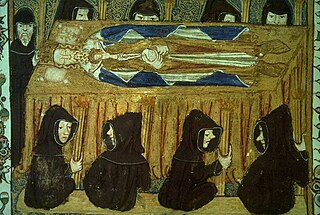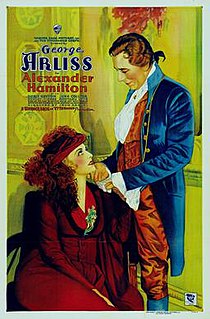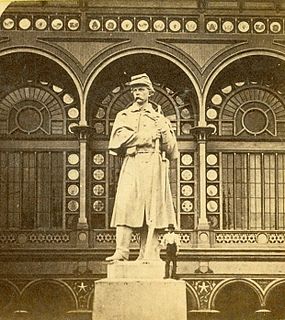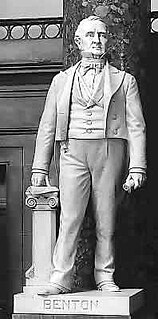
Alexander Hamilton was an American revolutionary, statesman and Founding Father of the United States. He was an influential interpreter and promoter of the U.S. Constitution, and was the founder of the Federalist Party, the nation's financial system, the United States Coast Guard, and the New York Post newspaper. As the first secretary of the treasury, Hamilton was the main author of the economic policies of the administration of President George Washington. He took the lead in the federal government's funding of the states' American Revolutionary War debts, as well as establishing the nation's first two de facto central banks, a system of tariffs, and the resumption of friendly trade relations with Britain. His vision included a strong central government led by a vigorous executive branch, a strong commercial economy, support for manufacturing, and a strong national defense.

Scene at the Signing of the Constitution of the United States is a 1940 oil-on-canvas painting by Howard Chandler Christy, depicting the Constitutional Convention signing the U.S. Constitution at Independence Hall in Philadelphia on September 17, 1787. Along with Washington Crossing the Delaware by Emanuel Leutze, the painting is one of the most famous depictions of the early days of the United States. Christy created the painting in April 1940; it is so large that he painted it in a sail loft. It currently is displayed along the east stairway in the House of Representatives wing in the Capitol building.

The Residence Act of 1790, officially titled An Act for establishing the temporary and permanent seat of the Government of the United States, is a United States federal statute adopted during the second session of the First United States Congress and signed into law by President George Washington on July 16, 1790. The Act provides for a national capital and permanent seat of government to be established at a site along the Potomac River and empowered President Washington to appoint commissioners to oversee the project. It also set a deadline of December 1800 for the capital to be ready, and designated Philadelphia as the nation's temporary capital while the new seat of government was being built. At the time, the federal government was operating out of New York City.

Lying in state is the tradition in which the body of a deceased official, such as a head of state, is placed in a state building, either outside or inside a coffin, to allow the public to pay their respects. It traditionally takes place in a major government building of a country, state, or city. While the practice differs among countries, in the United States, a viewing in a location other than a government building, such as a church, may be referred to as lying in repose. It is a more formal and public kind of wake or viewing. Lying in state often precedes a state funeral.

Federalist No. 61 is an essay by Alexander Hamilton, the sixty-first of The Federalist Papers. It was published on February 26, 1788 under the pseudonym Publius, the name under which all The Federalist papers were published. This is the last of three papers discussing the power of Congress over the election of its own members. It is titled "The Same Subject Continued: Concerning the Power of Congress to Regulate the Election of Members".
The Office of the Supervising Architect was an agency of the United States Treasury Department that designed federal government buildings from 1852 to 1939.

The Hall of Columns is a more than 100-foot-long (30 m) hallway lined with 28 fluted columns in the south wing extension of the United States Capitol in Washington, D.C. It is also the gallery for 18 statues of the National Statuary Hall Collection.

The National Capitol Columns are a monument in Washington, D.C.'s National Arboretum. It is an arrangement of twenty-two Corinthian columns which were a part of the United States Capitol from 1828 to 1958, placed amid 20 acres (8.1 ha) of open meadow, known as the Ellipse Meadow.

Ellington Showcase is an album by American pianist, composer and bandleader Duke Ellington recorded for the Capitol label at various sessions in 1953–55. The album has not been released on CD but the tracks have appeared on The Complete Capitol Recordings of Duke Ellington released by Mosaic Records in 1995.

Alexander Hamilton is a 1931 American pre-Code biographical film about Alexander Hamilton, produced and distributed by Warner Bros. and based on the 1917 play Hamilton by George Arliss and Mary Hamlin. It was directed by John G. Adolfi and stars Arliss in the title role. It follows the attempts of Hamilton to establish a new financial structure for the United States following the Confederation Period and the establishment of a new Constitution in 1787. It is preserved at the Library of Congress.

Carl H. Conrads was an American sculptor best known for his work on Civil War monuments and his two works in the National Statuary Hall Collection at the U.S. Capitol in Washington, D.C. He was also known as Charles Conrads.

Hamilton is a sung-and-rapped-through musical by the American composer and actor Lin-Manuel Miranda. Composed over a seven-year period from 2008 to 2015, the musical tells the story of American Founding Father Alexander Hamilton. Miranda said that he was inspired to write the musical after reading the 2004 biography Alexander Hamilton by Ron Chernow. Miranda says Hamilton was originally a hip hop album in his head. The show draws heavily from hip hop, as well as R&B, pop, soul, and traditional-style show tunes. It casts non-white actors as the Founding Fathers of the United States and other historical figures. Miranda described Hamilton as about "America then, as told by America now."

An outdoor 1908 sculpture of Alexander Hamilton by William Ordway Partridge is installed outside Hamilton Hall on the Columbia University campus in Manhattan, New York, United States.
Dale Fowler is an American politician who has served as a Republican member of the Illinois Senate since January 2017. Fowler represents the 59th district, which includes all of Franklin, Hamilton, Williamson, Saline, Gallatin, Hardin, Pope, Massac, Johnson, Pulaski, and Alexander counties and portions of Union and Jackson counties in Southern Illinois. Prior to his election to the Illinois Senate he was mayor of Harrisburg and a member of the Saline County Board. Fowler defeated incumbent Gary Forby (D), who had represented the district for 14 years. He has 2 children with his wife Jill Fowler. Fowler is a Presbyterian.

Alexander H. Stephens is a marble sculpture commemorating the American politician of the same name by Gutzon Borglum, installed in the United States Capitol as part of the National Statuary Hall Collection. The statue was gifted by the state of Georgia in 1927.

Thomas Hart Benton is a marble sculpture depicting the Senator from Missouri of the same name by Alexander Doyle, installed at the United States Capitol in Washington, D.C., as part of the National Statuary Hall Collection. The statue was gifted by the U.S. state of Missouri in 1899.

Francis Preston Blair Jr. is a marble sculpture depicting the American jurist, politician, and soldier of the same name by Alexander Doyle, installed in the United States Capitol's Hall of Columns, in Washington, D.C., as part of the National Statuary Hall Collection. The statue was gifted by the U.S. state of Missouri in 1899.

John E. Kenna is a 1901 marble sculpture of the American politician of the same name by Alexander Doyle, installed in the United States Capitol, in Washington, D.C., as part of the National Statuary Hall Collection. It is one of two statues donated by the state of West Virginia.

A colossal bust of Abraham Lincoln was made by Gutzon Borglum and completed in 1908. The original marble sculpture is installed in the United States Capitol crypt, in Washington, D.C. Copies cast in bronze are installed in several other locations, including the Lincoln Tomb in Springfield, Illinois.

There are several works of art in the United States Capitol honoring former leaders of the Confederate States of America and generals in the Confederate States Army, including eight statues in the National Statuary Hall Collection, busts and portraits.


















